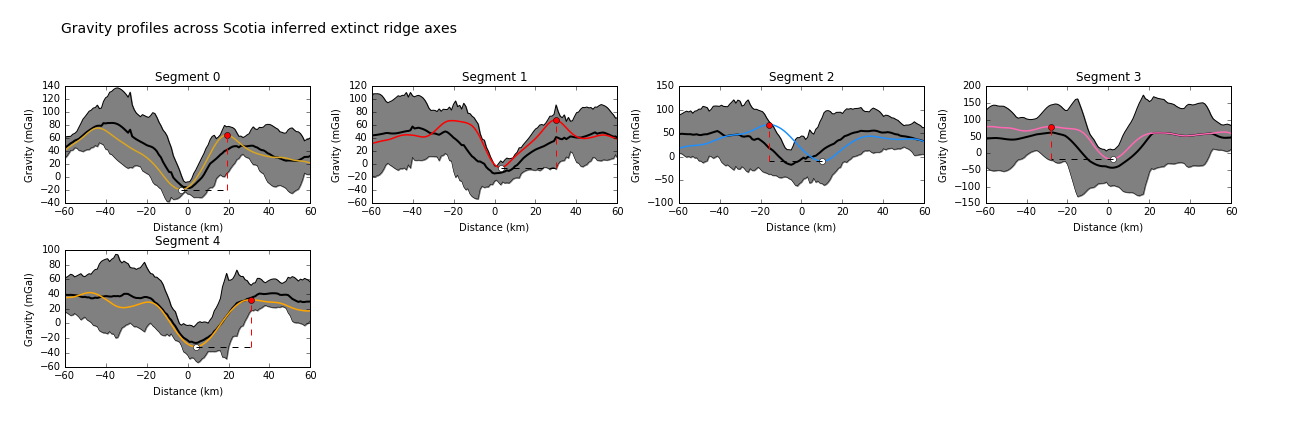| Ocean: | Marginal basin (situated between the southeast Pacific and southwest Atlantic oceans) |
| Spreading center type: | Large-scale MOR |
| Time of cessation: | Ca. 6 Ma, Chron C3A (Maldonado et al., 2000) |
| Subsequent active spreading center: | The active East Scotia Sea ridge is thought to have commenced spreading at 8 Ma, as a back-arc basin behind the South Scotia Trench and Island Arc (Barker et al., 1984). |
| Cessation style: | Spreading-rate gradually decreased from 16 Ma until the time of cessation (Maldonado et al., 2000) |
| Later deformation or volcanism: | None evident |
The western Scotia Sea contains a well-studied extinct ridge that was identified by the strong-bathymetric expression at the axial segments, symmetric magnetic anomalies about the former axis and the characteristic gravity low observed at the ridge axis (Barker and Burrell, 1977). In contrast, the ocean crust in the Central Scotia Sea is poorly understood and both the former spreading direction and age of the ocean floor remain unclear (Maldonado et al., 2000; Eagles and Jokat, 2014).
An early study by Barker and Burrell (1977) reported that spreading in the Western Scotia Sea commenced at around 29 Ma (anomaly C8), from their interpretation of available marine magnetic data. Their magnetic anomaly maps show symmetric, magnetic anomalies about the inferred ridge axis, with the youngest anomaly identified as C5 (Barker and Burrell, 1977). Numerous later studies have investigated the timing of spreading at the Scotia Sea extinct ridge because of its importance in relation to opening of the Drake Passage and commencement of the Antarctic Circumpolar Current (ACC) (for example, Lodolo et al., 2006; Eagles et al., 2006; Maldonado et al., 2014; Dalziel 2014).
The extinct ridge is strongly segmented and was digitized as five distinct segments for this review. On average the segments of the Western Scotia Sea Ridge have relief of ca. 1300 m between rift valleys and flanking ridges and the valleys are less than 30 km wide. The ocean floor within the Central Scotia Sea is more enigmatic and has led several authors to suggest that this may be due to the formation at a back-arc basin spreading center (Livermore et al., 1994; Barker et al., 1984). Unfortunately, current data does not provide adequate constraints for us to locate the Central Scotia Sea extinct spreading axis and it is not included in our comparison.
Barker, P. F., and Burrell, J., 1977, The opening of the Drake Passage, Marine Geology, v. 25, p. 15-34.
Dalziel, I. W. D, 2014, Drake Passage and the Scotia arc: A tortuous space-time gateway for the Antarctic Circumpolar Current, Geology, v. 42, no. 4, p. 367-368, doi: 10.1130/focus042014.1.
Eagles, G., Livermore, R. and Morris, P., 2006, Small basins in the Scotia Sea: The Eocene Drake Passage gateway, Earth and Planetary Science Letters, v. 242, p. 343-353.
Lodolo, E., Donda, F. and Tassone, A., 2006, Western Scotia Sea margins: improved comnstraints on the opening of the Drake Passage, Journal of Geophsycial Research, v. 111, no. B06, doi: 10.1029/2006JB004361.
Maldonado, A., Bohoyo, F., Galindo-Zaldivar, J., Hernandez-Molina, J., Lobo, F. J., Lodolo, E., Martos, Y. M., Perez, L. F., Schreider, A. A. and Somoza, L., 2014, A model of oceanic development by ridge jumping: Opening of the Scotia Sea. Global and Planetary Change, v. 123, p. 152-173, doi:10.1016/j.gloplacha.2014.06.010.
Maldonado, A., Balanyá, J.C., Barnolas, A., Galindo-Zaldívar, J., Hernández, J., Jabaloy, A., Livermore, R., Martínez-Martínez, J.M., Rodríguez-Fernández, J., De Galdeano, C.S. and Somoza, L., 2000, Tectonics of an extinct ridge-transform intersection, Drake Passage (Antarctica), Marine Geophysical Researches, v. 21, no. 1-2, p. 43-68.


